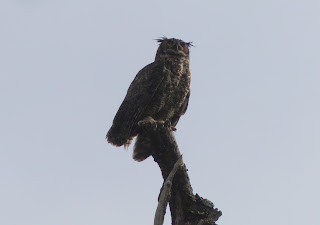Great Horned Owl
On iNaturalist I got a validation today for one of my owl pictures from 5 years ago, so let's do a Great Horned Owl for Throwback Thursday.
I suspect this picture came from back when Duke Farms was running periodic bird watching programs since the picture was taken before the core part of the property is open to the public (7:58 am).Great Horned Owls is probably our largest year-round owl, and thus near the top of the nocturnal food chain. They're presumed to have little sense of smell (like most birds) which probably makes them one of the few animals to prey on skunks. (I suspect Red-tailed Hawks would also go after skunks, but since skunks are nocturnal they're more likely to be found by owls.)
Crows understand the predacious nature of Great Horned Owls; if crows discover a GHO in their area, they'll almost certainly get together and try and harass the owl into leaving.
They have an attention-getting relative. Despite the lack of "horns" and their white color, the Snowy Owl is now considered to be closely related to the horned owls.
 |
| April 29, 2017 at Duke Farms Photo 7989307, (c) jpviolette, some rights reserved (CC BY-NC) |



Comments
Post a Comment